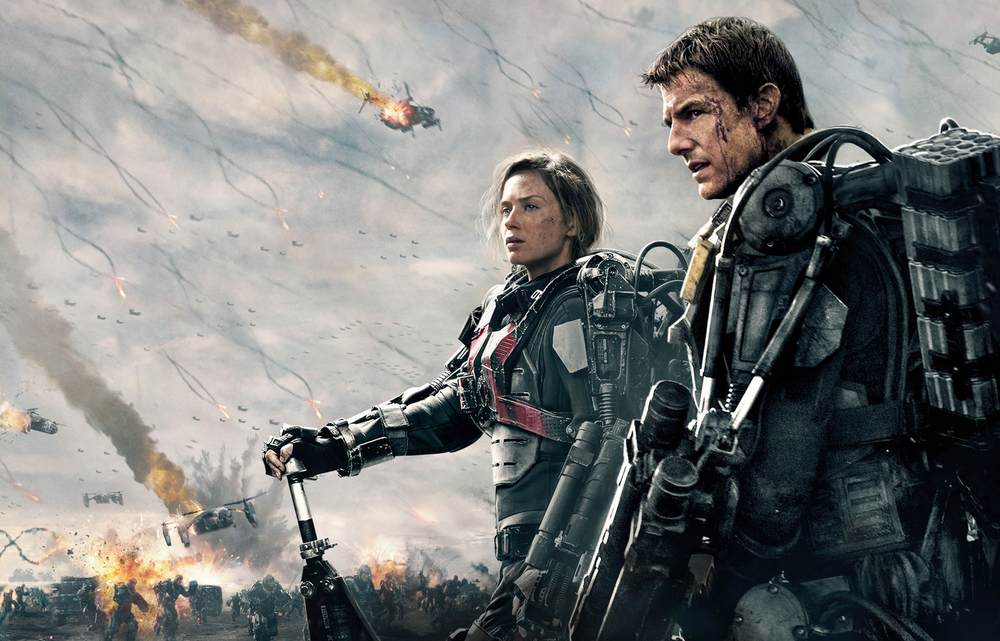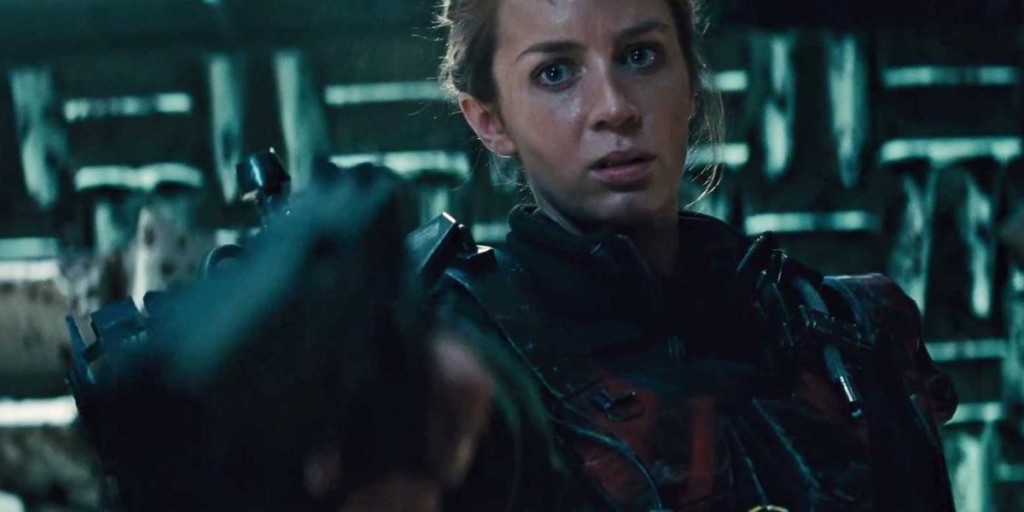Genre: Sci-fi
Premise: A soldier defending the earth from aliens finds himself reliving the last day of an impossible-to-win battle over and over again. Eventually, he begins to use this power to improve his fighting skills, in hopes of doing the unthinkable, leading his army to victory.
About: Maybe someone can clear this up for me. Does screenwriter D W Harper exist? An internet search brings up scant details (repped at CAA – he’s written a few in-development projects around town). Whenever a no-name comes out of nowhere and writes a script this good, my Spidey senses start tingling. A big writer known for another genre using an alias maybe? Furthermore, Harper, who scripted the draft of this script that sold for a million bucks (then titled “All You Need Is Kill”) is no longer in the credits for the film. Instead, Christopher McQuarrie leads the writing credit pack. For an idea this unique, you’d think that the original writer would obtain some credit, but I suppose not. Expanding the mystery, “Harper” has been chosen by Ridley Scott to script his dream sci-fi project, Forever War. So I don’t know what’s going on. But anyway, this is the original draft that sold and got everyone excited, before any writers came on to do rewrites. The film is directed by Doug Liman (The Bourne Identity), stars Tom Cruise and Emily Blunt, and comes out this June.
Writer: D W Harper (based on the novel “All You Need Is Kill” by Hiroshi Sakurazaka)
Details: 1st draft (4/1/2010)
I honestly didn’t think they’d ever make this movie. The action described on the page was unlike anything I’d seen before. One guy is fighting like hundreds of aliens at once. Repeatedly. I’m no visual effects artist, but each word I read felt like one of those Fourth of July sparklers. Except instead of sparkles, there were dollar signs shooting out. Maybe they’re funding this thing with bitcoins? I don’t know.
It also seemed a little over-concepty for Hollywood. A movie about aliens attacking earth is common. A time travel movie is common. But this script went ahead and bundled the two together. Typically when I run into scripts like this, or try and push scripts like this up the ladder, producers say the same thing – “There’s too much going on here.”
But All You Need Is Kill is a testament to how good writing can overcome this complaint. Simply put, if you write something good, it doesn’t matter if it breaks rules.
20 year old Cage (believe it or not, this is the role Cruise will play, no doubt rewritten) is a grunt soldier in a future where aliens have invaded earth and are systematically taking down continents one by one. They’ve destroyed all of North America, leaving Cage and the rest of his army to try and hold South America.
But Cage’s regiment is kinda fucked. When they go out to fight (in a battle known as “The Battle of Ruby Tuesday”), they get smoked by an alien force that mysteriously seems to know where they’re going to be before they do. As such, Cage and his army are slaughtered. That’s right, our hero dies within the first 15 minutes of the film!
Sora of. Seconds later Cage wakes up. He realizes it’s the day before the battle. Was what he just experienced a vivid dream? No. Cage finds himself living the exact same day over again, right up until the battle, where he and his group get slaughtered again. This keeps happening every day. For some reason, poor Cage is stuck in a loop.
The only thing Cage looks forward to is watching fellow soldier Rita (aka “Valkyrie One”), a recluse badass, rip hundreds of aliens to pieces every battle, even while all the soldiers around her die quick deaths. How is it, Cage wonders, that Rita is so much stronger than everyone else?
Cage finally gets the courage to hike over to Rita’s place before the battle, and over the course of many reboots, tells her his story, that he’s looping. She informs him that she’s also a looper, but has been doing so for way longer than him. Happy to have someone who understands her, Rita befriends Cage and starts training him. Together, they become an unstoppable force on the battlefield.
But what does winning the battle matter if they just keep looping back to the beginning? The two will have to figure out how to stop the loop, a process that involves killing the aliens that may have inadvertently given them the power to loop in the first place.
First off, if you write action scripts and you can get a hold of this script, read it. This is one of the best scripts as far as action-writing I’ve read.
Almost all the lines in the battles are two lines or less. Harper uses capitalizing to great effect to help key us in on important images (i.e. “TENS OF THOUSANDS OF OTHER JACKETED INFANTRY”). Harper uses iso-description to keep our eyes moving down the page. This means isolating action or subjects via a single line…
UP THE BEACH
IN THE SKY
OUT TO SEA
The writing favors flow over heavy description, yet still manages to pack a lot of information in it (“Worse yet, TWO MIMIC RUNNERS have detached and GIVE CHASE. YONABURU FIRES, taking one down, but the other is closing in.”). That’s one of the hardest things to do in sci-fi and fantasy. Your world is so unique that you can’t help but try and describe it all. But describe too much, and your action gets bogged down, which is the exact opposite of what you want to do with action. Harper has mastered this balance.
The script plays around with convention too. How bout meeting your man character, only to have him die within the first scene? Or how bout the “meet-cute” scene between our leads. Rita comes over as Cage is dying on the battlefield and tries to help him? Nope. She tells him she’s going to let him die here and then steals his battle-gear battery. Sounds like Harper got that meet-brute idea from a little screenwriting book I know.
I actually wanted to talk about the love story here because after watching the trailers for the film, I can see that they’ve changed it. In the script, Cage watches Rita from afar the whole time. She’s this unapproachable superstar fighting badass. She’s unattainable. A dream. It isn’t until the last 40 pages or so that the two start interacting.
Now normally I don’t like this. The traditional approach is to have your leads meet by the end of the first act at the latest (and in rare circumstances, by page 45), and then play around with their relationship over the rest of the story (guy gets girl, guy loses girl, or girl gets guy, girl loses guy, they get together again, lose each other again, you get the idea). But with All You Need Is Kill, the whole time looping element made that approach irrelevant. There was enough going on that we didn’t need to jump into the romantic relationship right away.
However, it appears that the studio didn’t agree with this approach and they’ve had the two get together a lot earlier. I understand why they did this. They want their male and female leads around each other. They want interaction. And to be honest, doing it the way they do it now would make me nervous too. Because it’s different. And nobody in this business likes to be too different. Actually, that’s not true. They like “different” in a spec because they’re tired of seeing the same old thing. But they haven’t invested 300 million dollars in a spec. So when actual money gets involved, they start worrying about all these “differences” and tend to mold the script back into something more traditional. This is often why good scripts become bad movies. Fear.
So I’m guessing that’s one of the things McQuarrie was asked to do. Move the timeline of the love story up. Have them get together earlier. And probably spend more time on that relationship in the film.
It looks like they also brought in an outside storyline. In the script, everything’s pretty contained. We’re either in the barracks or on the battlefield. Everything takes place in these two locations. In the trailer, there seems to be some government interference. We’re driving outside on roads, getting chased. There’s none of that here.
My guess is that the studio also got worried about the “too contained” aspect. When you’re plopping a film down in the middle of summer, it’s got to feel as big as possible. And even though the battlefield scenes look great in “Kill,” adding more locations gives the movie a “bigger” feel. It gives the studio more variety in the imagery, which they can use in the promotion.
I don’t know if that’s why they added that storyline or not, but that’s what it feels like to me.
All You Need Is Kill is one of these new breeds of spec sales where producers know how weary studios are of buying naked properties (spec scripts not adapted from anything). So they offer them a property that IS based on something, just not anything popular, to sort of trick them. This way, both sides win. Writer gets to sell his spec script and the studio gets to say they bought intellectual property.
What does that mean for writers who are writing naked specs? Simple, you just have to write something better. You have to write something awesome enough that people are willing to take a chance on you despite your script not be affiliated with IP.
All You Need Is Kill is one of my favorite spec scripts and is always flirting with my Top 25. A lot of people have this script so with some asking around and/or Google searching, you should be able to find it.
[ ] what the hell did I just read?
[ ] wasn’t for me
[ ] worth the read
[x] impressive
[ ] genius
What I learned: Remember, suspense is the act of suspending an event. If you have your hero look inside a room, you can show the audience what’s in that room a second later, or you can wait a few scenes until the hero brings his friends back. THEN show us what’s in the room. By suspending the event, you’re keeping us curious. That’s what Harper does here with Valkyrie One (Rita). We see her from afar but never meet her. Harper SUSPENDS the eventual meeting between Cage and Rita because he knows how much we want to see it. Whenever you’re writing a scene, ask yourself, “Is there anything here I can suspend?”



